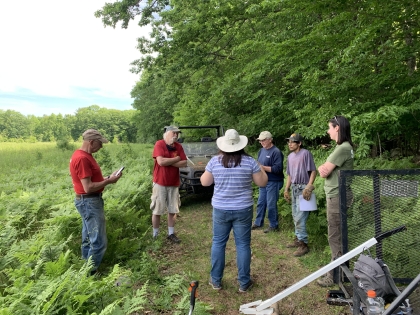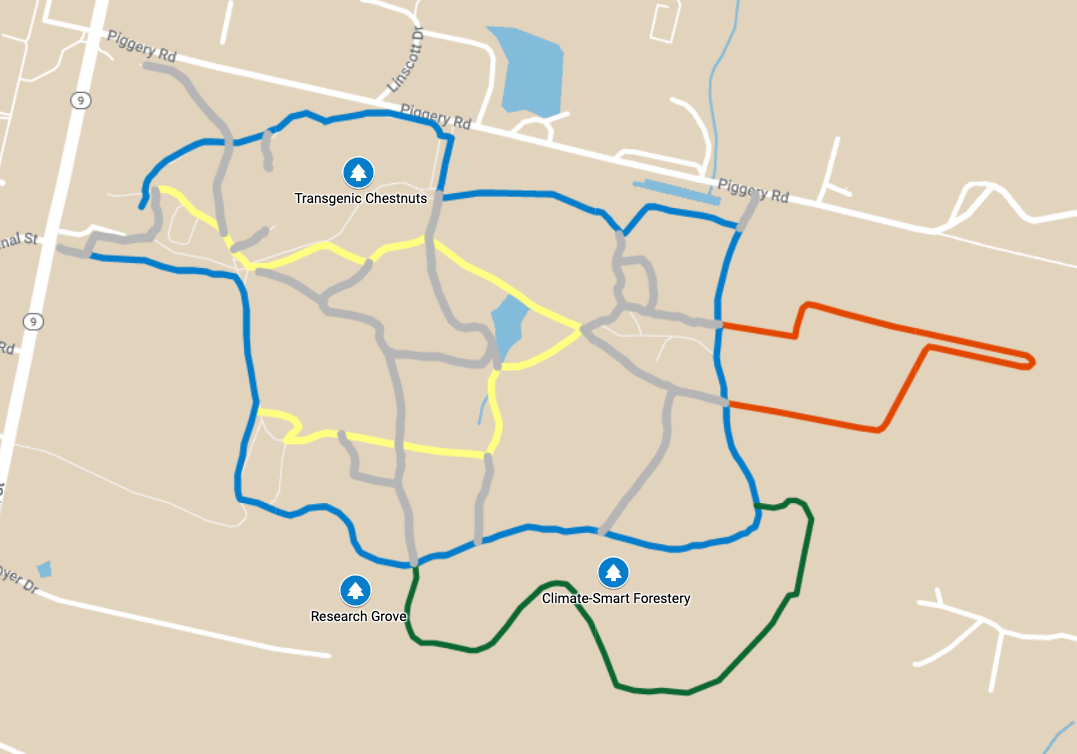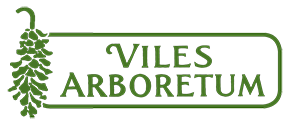The “Forest of the Future '' collection at Viles Arboretum is a series of tree installations designed to take visitors through an immersive, placed-based journey into Maine’s future woodlands. A whimsical concept, grounded in cutting-edge science which demonstrates many of the practices and technologies that Maine landowners can adopt as our State mobilizes to adapt to the impacts of climate change. This collection will have three planting sites, each of which demonstrates key technologies and tools in our fight against climate change.
How you can help
We're working closely with our partners to demonstrate some the fantastic science behind Maine's fight to help communities adapt to climate change and biodiversity loss; tools like biotechnology, low-impact forestry, and species selection. Your donation will help to secure key supplies and equipment needed to launch these projects this spring.
Your gift today will have double the impact thanks to a generous donor who will be matching donations up to $500.
DONATE TODAY!
Background
 Forests are a stabilizing force for our planet; regulating ecosystems, protecting biodiversity, and supplying key natural resources for economies everywhere. Forests are also one of the most important tools we have to address the effects of climate change; sequestering "approximately 2.6 billion tonnes of carbon dioxide, one-third of the CO2 released from burning fossil fuels," every year (1).
Forests are a stabilizing force for our planet; regulating ecosystems, protecting biodiversity, and supplying key natural resources for economies everywhere. Forests are also one of the most important tools we have to address the effects of climate change; sequestering "approximately 2.6 billion tonnes of carbon dioxide, one-third of the CO2 released from burning fossil fuels," every year (1).
"Created by Executive Order of Governor Janet Mills, the 'Forest Carbon Task Force' was recommended by the state’s new four-year climate action plan, 'Maine Won’t Wait,' and aims to develop a voluntary program for small-to-medium size woodland owners in Maine who want to utilize their land for long-term storage of carbon emissions, a process known as carbon sequestration. (2)"
However, as Maine Forests are being leveraged for carbon capture, some of Maine’s most important tree species face an array of ecological challenges caused by climate change; from warming temperatures and to new threats from diseases, insect pests, and invasive plants.
Climate change will likely result in changes to the ranges and abundance of our native wildlife as well. Many wildlife populations are projected to make a northward shift in search of suitable habitat. Slow dispersal rate of some tree species means that natural shifts in habitat may not match the migration rate of wildlife species that depend on them for food. The new concept of “assisted migration” by accelerating the movement of certain tree species may help reduce the gap between moving wildlife and their native habitats. This idea of “assisted migration” is one of the many research goals of the new Climate Forest at the Arboretum.
The Forest of the Future collection at the Arboretum aims to introduce North American tree species historically found in more southern hardiness zones to our current climate. Hardiness zones are areas that define the typical minimum and maximum yearly temperatures for an area, providing us with an idea of what plant species will grow effectively there. The Augusta area currently falls within zone 5 with minimum temperatures reaching between -10 and -20 degrees fahrenheit annually. By the year 2070, we are projected to fall within zone 6 or 7, with minimums falling somewhere between -10 and 10 degrees fahrenheit. By moving trees from zone 6 or 7 to our current climate we will be able to prepare our forests for projected future temperatures. Establishing mature seed bearing trees throughout our range means that these ecologically valuable species will be able to compete with invasive species as losses of current native species leave gaps in the ecosystem. Some of the species proposed for this planting include chestnut oak, sweetgum, redbud and tulip poplar.
Key Partners

METACF_letter_of_support_Viles_Arboretum_3.20.2023.pdf
Waldo_County_SWCD_Letter_of_Support_for_Viles_Arboretum_2023.docx_-_Google_Docs.pdf
Letter_of_Support_Andy_Shultz_-_Google_Docs.pdf
Objectives
- Demonstrate how gene editing technology can be used to create disease resistance and enable the restoration of a keystone species
- Demonstrate climate-smart forestry practices in a working woodlot.
- Facilitate research that explores tree species that may perform better in Maine's warming climate.
Botanical Installations
- Transgenic Chestnut garden
- Our third installation of chestnuts on the property; this exhibit will feature a small planting of the Darling 58 transgenic trees developed by the SUNY-ESF’s American Chestnut Research Lab.
- Climate-Smart Tree Farm
- The revitalization of our woodlot (Certified Tree Farm - 25+ Years) to model climate-smart forestry practices that sequester carbon and build resilience.
- A Research Grove
- A Planting of 140 trees of 14 species in a designed plot of 2.5-4 acres which will gather critical data on which cultivars may be best suited for Maine's warming climate

- “Forests and Climate Change.” IUCN, 2 Nov. 2022, https://www.iucn.org/resources/issues-brief/forests-and-climate-change.
- “Governor's Forest Carbon Task Force.” Governor's Forest Carbon Task Force | Oce of Policy Innovation & Future, https://www.maine.gov/future/initiatives/climate/climate-council/forest-carbon-taskforce.
Related Blog Post: https://vilesarboretum.org/about/blog/new-research-forest-coming-to-the-arboretum

